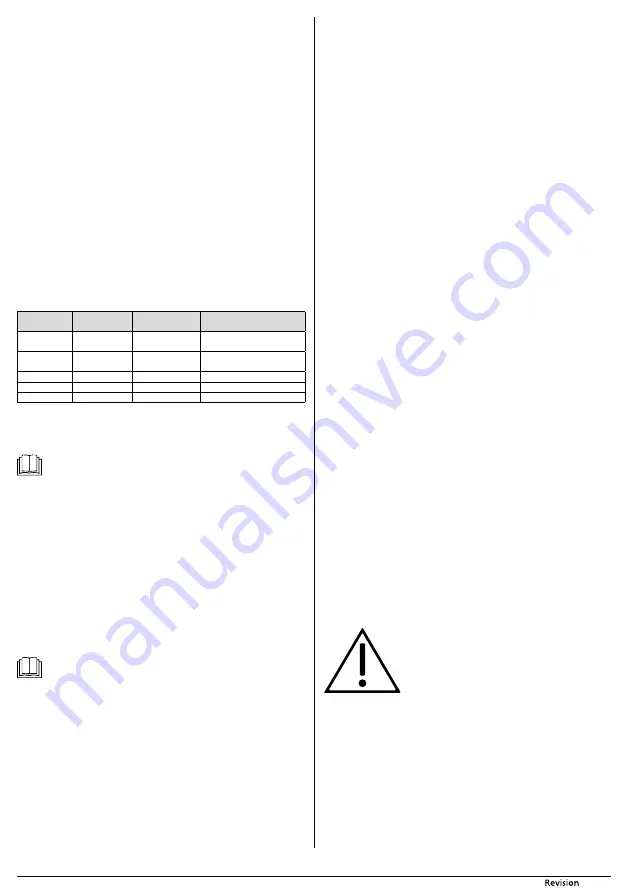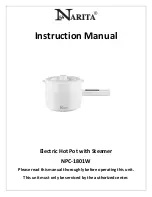
- 6 -
05/2019
Copyright © 2019, Fast ČR, a.s.
need small snacks that are not too crunchy. On the other hand, large dog breeds
can handle big and crunchy snacks. You can test their hardness by crushing a few
snacks in your hand.
■
Mix all the ingredients in a large bowl and form a loaf. On a floured cutting board,
roll out the dough to a height of approx. 6 mm. Then cut out your dog's favourite
shapes.
PLACING FOOD ON THE TRAYS
■
Arrange the cut pieces evenly on the trays, do not overlap the pieces, remembering
to leave gaps between the individual pieces. To ensure sufficient air circulation,
utilize approximately 85 % of each tray.
■
Underneath juicier foods it is better to put the drying insert in order to prevent juices
from dripping down on to the trays and to make subsequent maintenance easier.
OPERATION
TURNING ON THE FOOD DEHYDRATOR
■
Place the food dehydrator in a location according to the instructions in chapter
LOCATION OF THE FOOD DEHYDRATOR.
■
Insert the trays with the prepared food into the food dehydrator and properly close
the door.
■
Insert the power cord of the food dehydrator into a power socket and press button
B4
(START/STOP). The button will be backlit blue and the display will show a time
of 00:00.
DEHYDRATING USING PRESET MODES
■
If you wish to take advantage of one of the preset modes, press button
B5
(P). An
indicator will be lit at the first mode and the display will show the preset dehydration
time. Repeatedly press button
B5
(P) to cycle through the modes.
MODE
PRESET TIME
PRESET
TEMPERATURE
SUITABLE FOR
Jerky
05:00
70 °C
Dehydration of beef, game,
poultry or fish meat
Apples
08:00
65 °C
All types of fruit and
vegetables
Mushrooms
07:00
52 °C
Mushrooms
Herbs/Spices
02:00
46 °C
Herbs, spices and flowers
Pasta
03:00
57 °C
Pasta, yoghurts and porridge
■
Start dehydration by pressing button
B4
(START/STOP). The button will be backlit
red and the display will start gradually counting down the time.
■
During the dehydration process, time can be adjusted using buttons
B6
(-) and
B7
(+) in 30-minute increments.
Note:
On preset modes, it is not possible to change the dehydration process
temperature. Holding down button B5 (P) for a few seconds during the
dehydration process will only show the preset temperature.
DEHYDRATING WITH MANUAL TIME AND TEMPERATURE SETTINGS
■
If you want to use your own dehydration time, set it using buttons
B6
(-) and
B7
(+)
in 30-minute increments.
■
Using the temperature control knob
B1
, select the desired dehydration temperature.
■
Start dehydration by pressing button
B4
(START/STOP). The button will be backlit
red and the display will start gradually counting down the time.
■
You can adjust the time and temperature values at any time during the dehydration
process. You can check the temperature value by pressing button
B5
(P). The set
temperature will appear on the display for a few seconds.
CHECKING FOOD DURING THE DEHYDRATION PROCESS
■
If you wish to slide out any of the trays during the dehydration process to check the
condition of the food on it, simply open the door
A4
and slide the tray out.
■
Due to the temperature inside, use kitchen gloves to slide out the tray with the
food. Take out a food sample, allow it to cool down for a while and check it. In the
meantime, close the door.
Note:
If you press button
B4
(START/STOP) during the dehydration process, this
will end the dehydration process and the food dehydrator will turn of.
When the appliance is turned back on, it is not possible to continue on with
the dehydration process, it must be restarted or the respective time and
temperature must be set.
TURNING OFF THE FOOD DEHYDRATOR
■
To turn off the dehydrator, press button
B4
(START/STOP). A 9-second countdown
will start on the display and at its end the dehydrator will turn off completely.
■
Disconnect the power cord of the food dehydrator from the power socket. If you
wish to move the food dehydrator to another location, first allow it to cool down
completely.
FOOD DEHYDRATION TIPS
■
Experiment with the dehydration time to your own taste. Somebody prefers drier
and crunchier results, while somebody else gives preference to less dry product
with a tougher consistency. We recommend that you record the dehydration time
for individual types of foods.
■
When you wish to check the degree of dehydration, take out a handful of food and
allow it to cool down for a few minutes. Hot food appears to be softer, more moist
and more flexible than in its cooled state.
■
Before removing food from the trays, check that each and every piece is completely
dehydrated. When unsure, slice a piece in half and check the degree of dehydration.
■
Leave the dehydrated fruit, vegetables or mushrooms to cool for about 1 hour, if you
prefer inside the turned off food dehydrator. However, to not extend this cooling
time as dehydrated food may absorb moisture from the ambient air and thus require
further dehydration.
■
The food must be sufficiently dehydrated to prevent micro-organism from
multiplying and spoilage. Dehydrated vegetables must be hard and brittle, dried
fruit should be soft and flexible. For long term storage, home-grown fruit should be
drier than commercially bought dehydrated fruit.
■
We recommend inspecting the food every hour and in the event of uneven
dehydration, to rearrange the position of the food on the trays.
STORING DEHYDRATED FOOD
■
Before wrapping or storing dehydrated food, allow it to cool down first. Only use
suitable packaging for storage, for example glass canning jars, air-tight containers,
food-grade plastic bags or packaging, that are resistant against ingression of
moisture. Do not use plastic or aluminium containers. Metal cans with flip open lids
may be used only if the dehydrated food is placed in plastic bags.
■
Store dehydrated meat at room temperature in a closed container in a dry, dark
location. Stored in this way it will remain tasty and edible for several weeks or even
months.
■
Package dehydrated food in smaller amounts as tightly together as possible, but do
not push it against itself.
■
Do not store herbs and spices in paper bags because the oils contained in them will
be absorbed by the paper, which will ruin them. The best type of storage container
is again a glass jar with a firm locking mechanism, and in the case of flowers glass
jars with a wide neck for easy handling.
■
Place dried flowers, leaves and blossom petals into glass jars with a wide neck. When
necessary, add 3-4 drops of an aromatic oil to rejuvenate the fragrance and close
the container. Shake the contents and store them in a cool place. In this way, the
aromatic contents will always be available.
■
Ideally, store the containers in a dry, dark place at room temperature or lower. At
temperatures below 10 °C, their shelf life is extended by 2–3 times. Dried fruits have
a shelf life of at least 1-2 years.
■
Consume the entire contents after opening, ideally all at once. Inspect the stored
dehydrated food at least once per month.
■
Inspect dehydrated food regularly once per month. If you find mould on the
surface of the food, separate it from the remainder and dispose of it. Pasteurise
the remaining pieces that were not attacked by mould. To pasteurise the contents,
arrange the food on a cake baking tray and bake in an oven for approximately 15
minutes at a temperature of 80 °C. Then allow the food to cool down and repack
into a clean airtight package.
REHYDRATION
■
Rehydration serves to reconstitute food to its initial state. However, not all
dehydrated food must be reconstituted. Especially fruit is better in the dehydrated
state. On the other hand, most types of vegetables are tastier when reconstituted
to their initial state.
■
Through rehydration, food is returned practically to its initial size, shape and
appearance. If handled correctly, it retains most of its aroma and taste, as well as
minerals and a significant amount of vitamins.
■
To reconstitute vegetables for cooking, simply wash them in clean water and then
place them in cold, unsalted water and cover. If possible, allow them to soak for
approximately 2–8 hours, then cook them in the water that you used for soaking. If
necessary, add more water. Bring to a boil, then reduce the temperature and gently
cook until ready. At the end of the cooking process, you may also add salt, which
will slow down the reconstitution process. As far as fresh products are concerned,
overcooking them will reduce their aroma. To reconstitute vegetables, e.g. carrot,
use cold water for soaking. Dehydrated food may be reconstituted by soaking,
cooking or a combinations of both these methods and after reconstitution will look
similar to the fresh state.
Attention:
Dehydration does not rid food of bacteria, yeasts and
moulds. If you extend the soaking process at room
temperature, this will risk spoilage. Therefore, when soaking
fruit or vegetables for longer than 1–2 hours, place the
container into a refrigerator.
■
To prevent food from losing its nutritional value, use the water from the soaking
solution when preparing various recipes. The volume of one cup of dried vegetables
is equivalent to approx. 2 cups after reconstitution. To replace the moisture that was
removed during dehydration, pour cold water over the vegetables and soak them
from 20 minutes to 2 hours. Then pour boiling water over the vegetables. When
cooking, bring the vegetables to a boil and then leave them to simmer.
■
The volume of one cup of dried fruit is equivalent to approx. 1 1/2 cups after
reconstitution. Add just enough water to cover the fruit – its possible to add more
water later if necessary. 1–8 hours is sufficient for reconstituting the majority of
fruits. It depends on the type of fruit, size of pieces and water temperature (the
process is shorter in hot water). If the soaking time is too long, the fruit will lose
aroma. To cook reconstituted fruit, cover the container and simmer it in the water
in which you soaked it.
■
Dehydrated or reconstituted fruit and vegetables may be used in various ways.
■
Dehydrated fruit is suitable for preparing refreshments both at home and on trips.
Fruit pieces can be added to bread products or confectionery.
■
Reconstituted fruits can be served as compotes or sauces. They may also be used as
ingredients in recipes for making bread, jelly salads, omelettes, gugelhupf, stuffing,

























